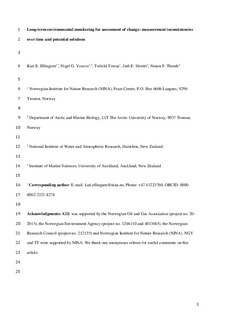| dc.contributor.author | Ellingsen, Kari Elsa | |
| dc.contributor.author | Yoccoz, Nigel Gilles | |
| dc.contributor.author | Tveraa, Torkild | |
| dc.contributor.author | Hewitt, Judi E. | |
| dc.contributor.author | Thrush, Simon F. | |
| dc.date.accessioned | 2017-11-10T12:26:55Z | |
| dc.date.available | 2017-11-10T12:26:55Z | |
| dc.date.created | 2017-11-02T12:21:01Z | |
| dc.date.issued | 2017 | |
| dc.identifier.issn | 0167-6369 | |
| dc.identifier.uri | http://hdl.handle.net/11250/2465552 | |
| dc.description.abstract | The importance of long-term environmental monitoring and research for detecting and understanding changes in ecosystems and human impacts on natural systems is widely acknowledged. Over the last decades, a number of critical components for successful long-term monitoring have been identified. One basic component is quality assurance/quality control protocols to ensure consistency and comparability of data. In Norway, the authorities require environmental monitoring of the impacts of the offshore petroleum industry on the Norwegian continental shelf, and in 1996, a large-scale regional environmental monitoring program was established. As a case study, we used a sub-set of data from this monitoring to explore concepts regarding best practices for long-term environmental monitoring. Specifically, we examined data from physical and chemical sediment samples and benthic macroinvertebrate assemblages from 11 stations from six sampling occasions during the period 1996–2011. Despite the established quality assessment and quality control protocols for this monitoring program, we identified several data challenges, such as missing values and outliers, discrepancies in variable and station names, changes in procedures without calibration, and different taxonomic resolution. Furthermore, we show that the use of different laboratories over time makes it difficult to draw conclusions with regard to some of the observed changes. We offer recommendations to facilitate comparison of data over time. We also present a new procedure to handle different taxonomic resolution, so valuable historical data is not discarded. These topics have a broader relevance and application than for our case study. Data comparability. Long-termmonitoring . Macrobenthos . Oil and gas industry . Taxonomic resolution | nb_NO |
| dc.language.iso | eng | nb_NO |
| dc.title | Long-term environmental monitoring for assessment of change: measurement inconsistencies over time and potential solutions | nb_NO |
| dc.type | Journal article | nb_NO |
| dc.type | Peer reviewed | nb_NO |
| dc.description.version | acceptedVersion | nb_NO |
| dc.subject.nsi | VDP::Zoologiske og botaniske fag: 480 | nb_NO |
| dc.subject.nsi | VDP::Zoology and botany: 480 | nb_NO |
| dc.source.volume | 189 | nb_NO |
| dc.source.journal | Environmental Monitoring & Assessment | nb_NO |
| dc.identifier.doi | 10.1007/s10661-017-6317-4 | |
| dc.identifier.cristin | 1510260 | |
| dc.relation.project | Miljødirektoratet: 4013045 | nb_NO |
| dc.relation.project | Egen institusjon: Norwegian institute for nature research (NINA) | nb_NO |
| dc.relation.project | Miljødirektoratet: 1204110 | nb_NO |
| dc.relation.project | Norsk olje og gass: 20-2013 | nb_NO |
| dc.relation.project | Norges forskningsråd: 212135 | nb_NO |
| cristin.unitcode | 7511,4,0,0 | |
| cristin.unitname | Tromsø | |
| cristin.ispublished | true | |
| cristin.fulltext | postprint | |
| cristin.qualitycode | 1 | |
